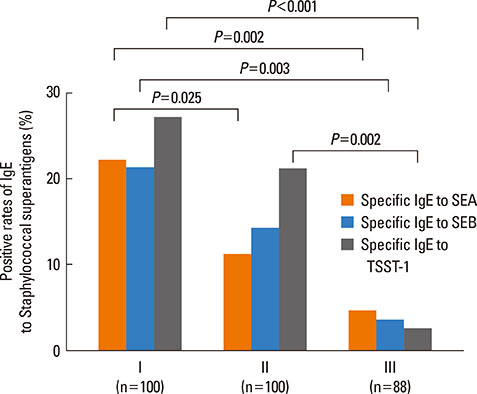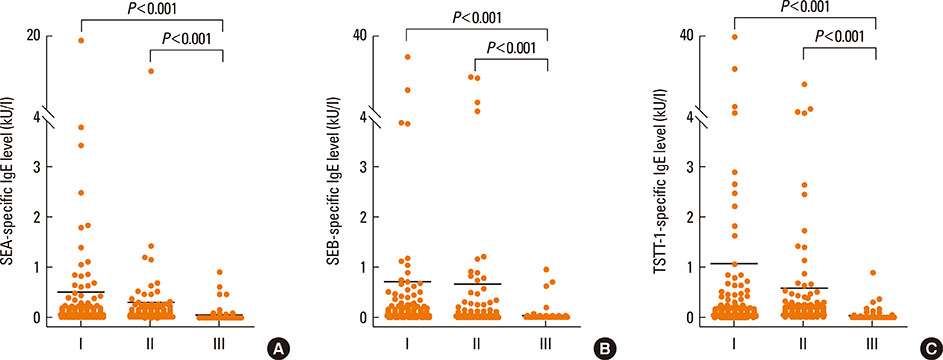Allergy Asthma Immunol Res.
2014 May;6(3):263-266. 10.4168/aair.2014.6.3.263.
The Prevalence of Serum Specific IgE to Superantigens in Asthma and Allergic Rhinitis Patients
- Affiliations
-
- 1Department of Allergy and Clinical Immunology, Ajou University School of Medicine, Suwon, Korea. hspark@ajou.ac.kr
- KMID: 2260690
- DOI: http://doi.org/10.4168/aair.2014.6.3.263
Abstract
- Staphylococcus aureus is the most common bacterium present in upper respiratory tract, and the toxins it produced are involved in allergic inflammation pathogenesis. In this study, we investigated the clinical significance of IgE in association with staphylococcal superantigens in allergic asthma with rhinitis (BAwAR) and allergic rhinitis alone (AR). We recruited 100 patients with BAwAR (group I), 100 patients with AR (group II), and 88 healthy controls (group III). Patients were clinically diagnosed by physicians, and were sensitized to house dust mites. Specific IgE antibodies to staphylococcal superantigen A (SEA), B (SEB), and toxic shock syndrome toxin-1 (TSST-1) were measured using the ImmunoCAP system. Other clinical parameters were retrospectively analyzed. All specific IgE antibodies to SEA, SEB, and TSST-1 were detected most frequently in group I (22%, 21%, and 27%), followed by group II (11%, 14%, and 21%) and group III (4.5%, 3.4%, and 2.3%). Absolute values of serum specific IgE to SEA, SEB, and TSST-1 were also significantly higher in group I (0.300+/-1.533 kU/L, 0.663+/-2.933 kU/L, and 0.581+/-1.931 kU/L) and group II (0.502+/-2.011 kU/L, 0.695+/-3.337 kU/L, and 1.067+/-4.688 kU/L) compared to those in group III (0.03+/-0.133 kU/L, 0.03+/-0.14 kU/L, and 0.028+/-0.112 kU/L). The prevalence of serum specific IgE to SEA was significantly higher in group I compared to group II (P=0.025). Blood eosinophil counts were significantly higher in patients with specific IgE to SEA or SEB, and higher serum levels of specific IgE to house dust mites were noted in patients with specific IgE to TSST-1. In conclusion, the present study suggested that IgE responses to staphylococcal superantigens are prevalent in the sera of both BAwAR and AR patients. This may contribute to an augmented IgE response to indoor allergens and eosinophilic inflammation.
MeSH Terms
Figure
Reference
-
1. Cruz AA, Popov T, Pawankar R, Annesi-Maesano I, Fokkens W, Kemp J, Ohta K, Price D, Bousquet J. ARIA Initiative Scientific Committee. Common characteristics of upper and lower airways in rhinitis and asthma: ARIA update, in collaboration with GA(2)LEN. Allergy. 2007; 62:Suppl 84. 1–41.2. Pastacaldi C, Lewis P, Howarth P. Staphylococci and staphylococcal superantigens in asthma and rhinitis: a systematic review and meta-analysis. Allergy. 2011; 66:549–555.3. Park HS, Choi GS, Cho JS, Kim YY. Epidemiology and current status of allergic rhinitis, asthma, and associated allergic diseases in Korea: ARIA Asia-Pacific workshop report. Asian Pac J Allergy Immunol. 2009; 27:167–171.4. Lundbäck B. Epidemiology of rhinitis and asthma. Clin Exp Allergy. 1998; 28:Suppl 2. 3–10.5. Bachert C, Gevaert P, Zhang N, van Zele T, Perez-Novo C. Role of staphylococcal superantigens in airway disease. Chem Immunol Allergy. 2007; 93:214–236.6. Bachert C, Zhang N, Holtappels G, De Lobel L, van Cauwenberge P, Liu S, Lin P, Bousquet J, Van Steen K. Presence of IL-5 protein and IgE antibodies to staphylococcal enterotoxins in nasal polyps is associated with comorbid asthma. J Allergy Clin Immunol. 2010; 126:962–968. 968.e1–968.e6.7. Rossi RE, Monasterolo G. Prevalence of serum IgE antibodies to the Staphylococcus aureus enterotoxins (SAE, SEB, SEC, SED, TSST-1) in patients with persistent allergic rhinitis. Int Arch Allergy Immunol. 2004; 133:261–266.8. Ikezawa Z, Komori J, Ikezawa Y, Inoue Y, Kirino M, Katsuyama M, Aihara M. A role of Staphyococcus aureus, interleukin-18, nerve growth factor and semaphorin 3A, an axon guidance molecule, in pathogenesis and treatment of atopic dermatitis. Allergy Asthma Immunol Res. 2010; 2:235–246.9. Hauk PJ, Wenzel SE, Trumble AE, Szefler SJ, Leung DY. Increased T-cell receptor vbeta8+ T cells in bronchoalveolar lavage fluid of subjects with poorly controlled asthma: a potential role for microbial superantigens. J Allergy Clin Immunol. 1999; 104:37–45.10. Shiomori T, Yoshida S, Miyamoto H, Makishima K. Relationship of nasal carriage of Staphylococcus aureus to pathogenesis of perennial allergic rhinitis. J Allergy Clin Immunol. 2000; 105:449–454.11. Losol P, Kim SH, Hwang EK, Shin YS, Park HS. IL-5 promoter polymorphism enhances IgE responses to staphylococcal superantigens in adult asthmatics. Allergy Asthma Immunol Res. 2013; 5:106–109.12. Montefort S, Ellul P, Montefort M, Caruana S, Agius Muscat H. Increasing prevalence of asthma, allergic rhinitis but not eczema in 5- to 8-yr-old Maltese children (ISAAC). Pediatr Allergy Immunol. 2009; 20:67–71.13. Fan CH, Yang TS, Tang SM, Wang Q, Zhang Z. Diagnostic significance of serum allergen detection in diagnosis of allergic rhinitis and bronchial asthma. Zhonghua Yi Xue Za Zhi. 2008; 88:3422–3424.14. Brozek JL, Baena-Cagnani CE, Bonini S, Canonica GW, Rasi G, van Wijk RG, Zuberbier T, Guyatt G, Bousquet J, Schünemann HJ. Methodology for development of the Allergic Rhinitis and its Impact on Asthma guideline 2008 update. Allergy. 2008; 63:38–46.15. Hamelmann E, Rolinck-Werninghaus C, Wahn U, Kopp MV. Treatment with a combination of anti-IgE and specific immunotherapy for allergic rhinitis and asthma. Arb Paul Ehrlich Inst Bundesinstitut Impfstoffe Biomed Arzneim Langen Hess. 2009; 96:303–313.16. Humbert M, Beasley R, Ayres J, Slavin R, Hébert J, Bousquet J, Beeh KM, Ramos S, Canonica GW, Hedgecock S, Fox H, Blogg M, Surrey K. Benefits of omalizumab as add-on therapy in patients with severe persistent asthma who are inadequately controlled despite best available therapy (GINA 2002 step 4 treatment): INNOVATE. Allergy. 2005; 60:309–316.17. Bossley CJ, Fleming L, Gupta A, Regamey N, Frith J, Oates T, Tsartsali L, Lloyd CM, Bush A, Saglani S. Pediatric severe asthma is characterized by eosinophilia and remodeling without T(H)2 cytokines. J Allergy Clin Immunol. 2012; 129:974–982.18. Bachert C, van Steen K, Zhang N, Holtappels G, Cattaert T, Maus B, Buhl R, Taube C, Korn S, Kowalski M, Bousquet J, Howarth P. Specific IgE against Staphylococcus aureus enterotoxins: an independent risk factor for asthma. J Allergy Clin Immunol. 2012; 130:376–381.
- Full Text Links
- Actions
-
Cited
- CITED
-
- Close
- Share
- Similar articles
-
- Relationship between serum total IgE, specific IgE, and peripheral blood eosinophil count according to specific allergic diseases
- Serum Specific IgE to Staphylococcal Superantigens in Sera of ASA-intolerant Asthma
- Diagnosis of Allergic Rhinitis
- Dermographism ( IV ): The Prevalence in Atopic Dermatitis and Allergic Rhinitis
- The Correlation Study between the Specific IgE for Staphylococcus Aureus Exotoxin and Nasal Mucus Culture in Allergic Rhinitis



